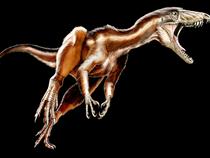Tawa Hallae
Homepage > Dinosaur Discoveries - Tawa Hallae
 U.S.
paleontologists reported in the latest issue of Science the fossils of
a new dinosaur, Tawa häl, about 220 million years old and could give more
information about the early years of dinosaur evolution. Tawa's skeleton,
the most complete and best preserved of the Triassic period (makes between
251 and 199 million years), supports the theory that dinosaurs originated
in South America.
U.S.
paleontologists reported in the latest issue of Science the fossils of
a new dinosaur, Tawa häl, about 220 million years old and could give more
information about the early years of dinosaur evolution. Tawa's skeleton,
the most complete and best preserved of the Triassic period (makes between
251 and 199 million years), supports the theory that dinosaurs originated
in South America.
When the dinosaurs emerged during the Triassic Period, they lived in Pangea, an unified land mass that was broken in two continents. Tawa häl, was discovered in 2004 at Ghost Ranch (New Mexico). Researchers believe that dinosaurs originated in South America and from that time were differentiated into three groups (ornithischians, sauropods and theropods) and then dispersed throughout the world.
"Tawa opens a new window into the early evolution of dinosaurs, provides information on the relationship between the first dinosaurs, and reveals how it swept the globe. It also gives us new insights into the evolution and characteristics," says Sterling Nesbitt, lead author and researcher at the University of Texas at Austin (USA).
Tawa has traits of his contemporaries and others who had not appeared, so this is a discovery that helps to unify the Triassic carnivorous dinosaurs in the same group of theropods, which also included Tyrannosaurus rex, and more recently to the birds.
Scientists discovered three separate but related carnivore findings in the late Triassic beds that contain abundant fossils. These findings suggest that each descended from a different lineage before their arrival in America and had evolved from a common local ancestor. Besides Tawa, researchers found fossils of a carnivorous dinosaurs that are related to Coelophysis common in this region, and fossils of other carnivorous species associated with Herrerasauria, who lived in South America.
Special Characteristics and differences among these carnivores are used to identify Tawa. These characteristics imply that Tawa is from separate lineages. Unlike many theropods, the lineage of Tawa does not lead directly to the birds.
Researchers believe that the fossils from Tawa fill the morphological gap, caused by an incomplete collection of fossils. One of the most significant morphological gaps among the Herrerasauria and animals like birds, like Coelophysis. Tawa fits perfectly between both groups.